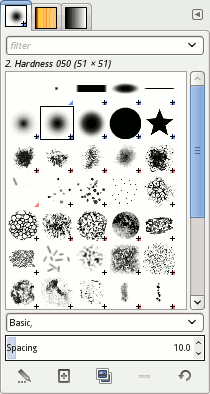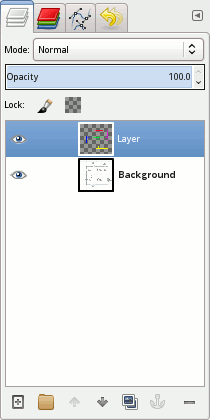GIMP
The Free & Open Source Image Editor
This is the official website of the GNU Image Manipulation Program (GIMP).
GIMP is a cross-platform image editor available for GNU/Linux, macOS, Windows and more operating systems. It is free software, you can change its source code and distribute your changes.
Whether you are a graphic designer, photographer, illustrator, or scientist, GIMP provides you with sophisticated tools to get your job done. You can further enhance your productivity with GIMP thanks to many customization options and 3rd party plugins.
GIMP (/ɡɪmp/ GHIMP; GNU Image Manipulation Program) is a free and open-source raster graphics editor used for image manipulation (retouching) and image editing, free-form drawing, transcoding between different image file formats, and more specialized tasks. It is not designed to be used for drawing, though some artists and creators have used it for such.
GIMP is released under the GPL-3.0-or-later license and is available for Linux, macOS, and Microsoft Windows.
Features
Tools used to perform image editing can be accessed via the toolbox, through menus and dialogue windows. They include filters and brushes, as well as transformation, selection, layer and masking tools.
Color
There are several ways of selecting colors, including palettes, color choosers and using an eyedropper tool to select a colour on the canvas. The built-in color choosers include RGB/HSV/LAB/LCH selector or scales, water-color selector, CMYK selector and a color-wheel selector. Colors can also be selected using hexadecimal color codes, as used in HTML color selection. GIMP has native support for indexed colour and RGB color spaces; other color spaces are supported using decomposition, where each channel of the new color space becomes a black-and-white image. CMYK, LAB and HSV (hue, saturation, value) are supported this way. Color blending can be achieved using the Blend tool, by applying a gradient to the surface of an image and using GIMP’s color modes. Gradients are also integrated into tools such as the brush tool, when the user paints this way the output color slowly changes. There are a number of default gradients included with GIMP; a user can also create custom gradients with tools provided. Gradient plug-ins are also available.
Selections and paths
GIMP selection tools include a rectangular and circular selection tool, free select tool, and fuzzy select tool (also known as magic wand). More advanced selection tools include the select by color tool for selecting contiguous regions of color—and the scissors select tool, which creates selections semi-automatically between areas of highly contrasting colors. GIMP also supports a quick mask mode where a user can use a brush to paint the area of a selection. Visibly this looks like a red colored overlay being added or removed. The foreground select tool is an implementation of Simple interactive object extraction (SIOX), a method used to perform the extraction of foreground elements, such as a person or a tree in focus. The Paths Tool allows a user to create vectors (also known as Bézier curves). Users can use paths to create complex selections, including around natural curves. They can paint (or “stroke”) the paths with brushes, patterns, or various line styles. Users can name and save paths for reuse.
Image editing
There are many tools that can be used for editing images in GIMP. The more common tools include a paint brush, pencil, airbrush, eraser and ink tools used to create new or blended pixels. The Bucket Fill tool can be used to fill a selection with a color or pattern. The Blend tool can be used to fill a selection with a color gradient. These color transitions can be applied to large regions or smaller custom path selections.
GIMP also provides “smart” tools that use a more complex algorithm to do things that otherwise would be time-consuming or impossible. These include:
- Clone tool, which copies pixels using a brush
- Healing brush, which copies pixels from an area and corrects tone and color
- Perspective clone tool, which works like the clone tool but corrects for distance changes
- Blur and sharpen tool blurs and sharpens using a brush
- The Smudge tool can be used to subtly smear a selection where it stands.
- Dodge and burn tool is a brush that makes target pixels lighter (dodges) or darker (burns)
Layers, layer masks and channels
An image being edited in GIMP can consist of many layers in a stack. The user manual suggests that “A good way to visualize a GIMP image is as a stack of transparencies,” where in GIMP terminology, each level (analogous to a transparency) is called a layer. Each layer in an image is made up of several channels. In an RGB image, there are normally 3 or 4 channels, each consisting of a red, green and blue channel. Color sublayers look like slightly different gray images, but when put together they make a complete image. The fourth channel that may be part of a layer is the alpha channel (or layer mask). This channel measures opacity where a whole or part of an image can be completely visible, partially visible or invisible. Each layer has a layer mode that can be set to change the colors in the image.
Text layers can be created using the text tool, allowing a user to write on an image. Text layers can be transformed in several ways, such as converting them to a path or selection.

Droste effect using Mathmap plug-in
Automation, scripts and plug-ins
GIMP has approximately 150 standard effects and filters, including Drop Shadow, Blur, Motion Blur and Noise.
GIMP operations can be automated with scripting languages. The Script-Fu is a Scheme-based language implemented using a TinyScheme interpreter built into GIMP. GIMP can also be scripted in Perl,Python (Python-Fu), or Tcl, using interpreters external to GIMP. New features can be added to GIMP not only by changing program code (GIMP core), but also by creating plug-ins. These are external programs that are executed and controlled by the main GIMP program. MathMap is an example of a plug-in written in C.
There is support for several methods of sharpening and blurring images, including the blur and sharpen tool. The unsharp mask tool is used to sharpen an image selectively – it sharpens only those areas of an image that are sufficiently detailed. The Unsharp Mask tool is considered to give more targeted results for photographs than a normal sharpening filter. The Selective Gaussian Blur tool works in a similar way, except it blurs areas of an image with little detail.
GIMP-ML is an extension for machine learning with 15 filters.
GEGL
The Generic Graphics Library (GEGL) was first introduced as part of GIMP on the 2.6 release of GIMP. This initial introduction does not yet exploit all of the capabilities of GEGL; as of the 2.6 release, GIMP can use GEGL to perform high bit-depth color operations; because of this less information is lost when performing color operations. When GEGL is fully integrated, GIMP will have a higher color bit depth and better non-destructive work-flow. GIMP 2.8.xx supports only 8-bit of color, which is much less than what e.g. digital cameras produce (12-bit or more). Full support for high bit depth is included with GIMP 2.10. OpenCL enables hardware acceleration for some operations.
CTX
CTX is a new rasterizer for vector graphics in GIMP 3.0. Some simple objects like lines and circles can be reduced to vector objects.
File formats
GIMP supports importing and exporting with a large number of different file formats, GIMP’s native format XCF is designed to store all information GIMP can contain about an image; XCF is named after the eXperimental Computing Facility where GIMP was authored. Import and export capability can be extended to additional file formats by means of plug-ins. XCF file size is extended to more than 4 GB since 2.9.6 and new stable tree 2.10.x.
| File formats | |
|---|---|
| Import and export | GIMP has import and export support for image formats such as BMP, JPEG, PNG, GIF, TIFF and HEIF,[better source needed] along with the file formats of several other applications such as Autodesk flic animations, Corel PaintShop Pro images, and Adobe Photoshop documents. Other formats with read/write support include PostScript documents, X bitmap image, xwd, and Zsoft PCX. GIMP can also read and write path information from SVG files and read/write ICO Windows icon files. |
| Import only | GIMP can import Adobe PDF documents and the raw image formats used by many digital cameras, but cannot save to these formats. An open source plug-in, UFRaw (or community supported fork nUFRAW), adds full raw compatibility, and has been noted several times for being updated for new camera models more quickly than Adobe’s UFRaw support. |
| Export only | GIMP can export to MNG layered image files (Linux version only) and HTML (as a table with colored cells), C source code files (as an array) and ASCII art (using a plug-in to represent images with characters and punctuation making up images), though it cannot read these formats. |
PROS
- Offers plugin support
CONS
Pricing
GIMP is a cross-platform image editor available for GNU/Linux, macOS, Windows and more operating systems. It is free software, you can change its source code and distribute your changes.












